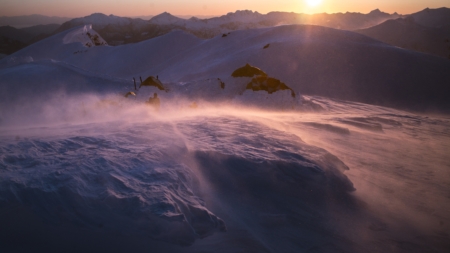What Do the Winds Bring?
After surviving calamity in British Columbia’s Coast Mountains, a few skiers return to COVID-19.
Just when you think you know what you’re doing, something unseen comes ripping around the corner with such unrelenting force that all you can do is dig yourself into the earth and hope there is room for mercy beneath the open and endless expanse of midnight sky.
The Tantalus Range unfolds before us, our eyes squinting into the rising sun. Through the window, wisps of crystal dust twirl across the shaded slopes below, only to be gobbled up by the rotor wash as we touch down on a snowy shoulder below Mount Dione’s west face. The pilot’s thumb goes up, the doors open, and we pile out. Kye Petersen ducks low around the nose of the machine while Nick Russell pops the tail compartment; duffels and tents, totes full of food, fuel, stoves, skis and boots all pile up while our crunched bodies move to the frenzied tempo of a NASCAR pit crew working nine feet below the 35-foot long blades.
Once we’re clear the pilot throttles up to 390 RPM, the air pressure around us increases, the noise escalates and the one-ton machine pulls away from the slope. The air remains agitated for a few seconds, but then the slow breeze returns, bringing with it the silent clarity that only exists above tree line. A cloud of shimmers swirl across the contours of the snow, drawing wild looping characters, and I want to just sit there and watch. Leo Hoorn, Blake Jorgenson, Logan Pehota, Matty Richard and Rob Massie—all local skiers from the Whistler-Pemberton corridor—are already moving the first two loads of gear down to a flat spot on the shoulder. I turn to join them as a gust of air scrawls something at my feet. I shoulder a bag. Camp must be built.
The weather has been increasingly variable in the southern Coast Mountains of British Columbia. This season started out slow; accumulation was next to nil until January, but after that each system has come in hard and fast, and the early spring snowpack still shows these volatile swings. But now a window of opportunity is approaching, or so we think. We have arrived in a break between one weather system and the next, and we’re planning on staying one week; the forecast shows moderate winds from the north will bring scattered flurries tomorrow, followed by a window of high pressure. If our timing is right, all we have to do is hunker down so as to be taut and ready to spring into action once the skies clear.
We set up the two large community domes and six personal tents and start carving our way into the ridge. Snow is such an incredible medium—it stacks, it packs, it sculpts—it’s even possible to hold a person’s body weight on a cord tied to a lighter, if the lighter is buried deep enough and placed just right in the snow. With this in mind, we fill stuffsacks with snow, bury them and rig the tents tight to keep the cluster of colorful nylon fixed to the mountain. Slowly camp takes shape; pathways here, windbreaks there, a compromise between the flow of our movements and the preparations for the incoming storm.
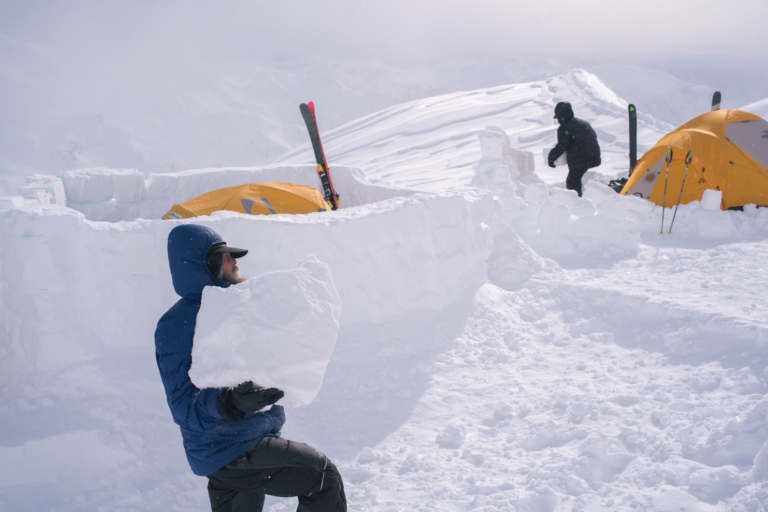
Leo Hoorn and Kye Petersen fortify base camp. Coast Mountains, British Columbia. Kieran Brownie
We fill the time between work with stories and snacks, waiting out the day till dusk settles in. Eventually it comes, our voices slow and our minds begin to wander upward to the potential that lurks in the clouds, with the wintered peaks, to the things they take and all they provide. We brew up tea and add a little whiskey while the wind drums steadily against the walls of the tent.
Eventually I leave the cook-shack to retrieve a battery from the other dome. There are two entrances to the tent, but the wind has shifted a bit and now only one is usable. Even on the lee-ward side a gust blows the zipper from my fingers, and it takes a second to wrestle it back into place before I can clamber in, sidestepping sleeping pads and camera bags to access the other side of the tent and my backpack. As I dig around in the bag, the noise outside drops for a moment, and then it hits. All at once the floor balloons up and the ceiling slams down. It takes all my energy to stand with both hands pushing against the nylon walls as the dome threatens to collapse.
No matter how loud I yell I can barely hear myself, let alone communicate to the rest of the crew in the cook-tent, ten feet away. I can feel my feet sliding into a soft spot under the tent, the wind auguring me into the ground. I fight back for a bit, like a fish on a wire, slowly tiring, knowing that I don’t stand a chance, and yet I still participate.
Finally I am able to regain my footing enough to make a break for it and lunge for the tent door. Unzipping and rolling out as fast as I can in case my weight was the only thing keeping the tent from taking flight, I scuttle through camp and duck into the cook-tent. Everyone is still sipping tea. “Guys, I think we’re in trouble,” I sputter while receiving looks of mild confusion from half-sedated faces. I can’t even take myself seriously now, it doesn’t sound that bad outside.
But then another gust hits, and the cook-tent pulls tight, tent poles bending, and suddenly bodies spring into motion, spilling out into chaos. It’s 8 p.m.
Snow is moving dead-horizontal at speeds that scatter us about camp. The two domes are taking the brunt of the wind—if we lose the cook-tent we lose the food, if we lose the other dome Blake and I lose all of our camera equipment—but even the smaller pup tents for sleeping, which are tucked behind walls of snow, are stressed. We lean into the wind, scrambling to protect what we can. The round bench that someone had built for outdoor meals in the balmy week ahead is rapidly quarried for blocks. Every available item is buried in the snow to keep the tents from jumping around. Then the frame of Nick’s tent explodes. He grabs his sleeping bag and backpack before the wind gets a chance and quickly relocates his belongings while the rest of us continue cutting, passing and stacking until the windbreaks are looming overhead. And yet, the force of the arctic outflow seems to be increasing.
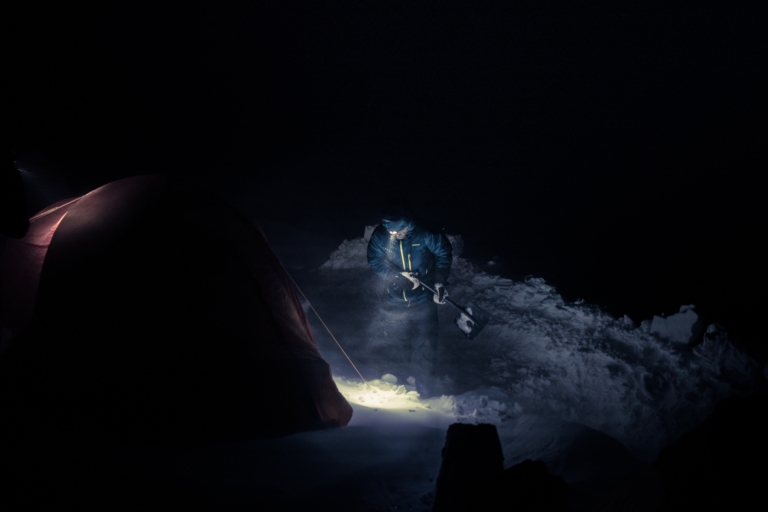
One for all and all for one. Nick Russell helping to anchor Rob Massie’s tent, shortly before his own exploded. Coast Mountains, British Columbia. Kieran Brownie
After two hours outside, Blake and I head back to our dome and find Nick inside bracing the walls while nervously eyeing the seams with each gale. The most dangerous moments are the lulls: the wind relaxes, we relax, and then SNAP it comes back twice as hard, cracking fabric like a whip. I crawl into my sleeping bag, lie in the dark and find myself obsessing over the sound. I can feel my ears searching, anticipating the next gust. Then a voice, barely audible, is shouting outside. Matty is at the door. The cook-shack has blown out and he’s yelling, “All hands on deck!”
Out into the storm again, and this time it’s worse. The wind is moving more snow, each of us is working shoulder to shoulder and yet we must use sign language to communicate. Blocks are cut, sculpted, placed and packed while our faces rapidly accumulate rime. Two poles have snapped and the cook-shack is flattened. We wrap ropes around the whole thing to keep it grounded, build more walls, and all the while we take turns bending at the waist to try and peel half-inch-thick ice from our eyelashes. We are incapacitated by the wind; blind, deaf and seemingly drunk as we stumble, leaning and weaving between the narrow corridors of walls and tents. It’s after midnight when I collapse on top of my sleeping bag, wondering how bad it could get.
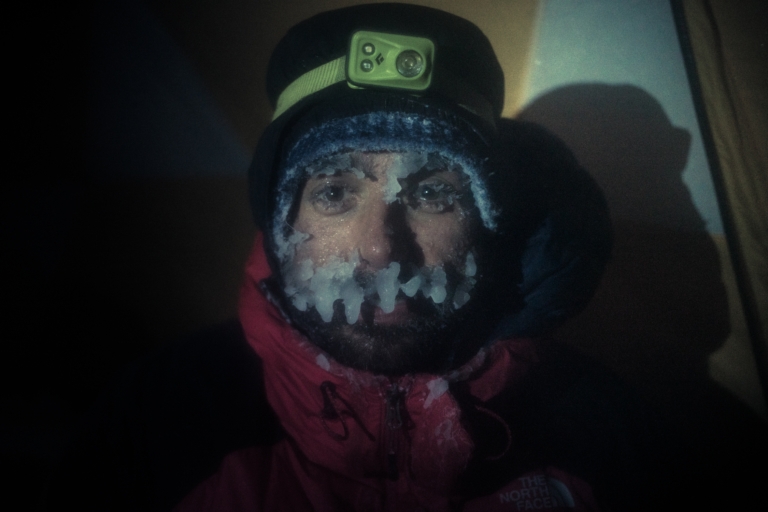
Rob Massie under a layer of rime. Coast Mountains, British Columbia. Kieran Brownie
Then the door flies open and Rob comes piling into the dome. In true Canadian style he apologizes while explaining how as he sat in his tent with his arms pressed into the ceiling and snow piling up around him, the fabric shredded and he found himself holding up a framework of twisted poles, and if he could be so forward as to request sleeping in the dome with Blake and Nick and me, that he would be very thankful but also so sorry for the trouble! We shuffle around as he finds a space to lie down.
Once again my mind wisps away to the movement of the air. I wonder if we should have our radios on, in case one of the pup tents blows away with someone in it? Otherwise, how would we know? We should have dug a snow cave from the get-go, blocked some of the wind, saved a lot of energy in the long run. But none of us expected this—we wouldn’t be here if we had known—nobody foresaw the trouble we would be in, and nobody thought to prepare for the worst. It is an interesting heuristic, that we find it difficult to foresee certain things that exist just beyond our own experience; we tend to prepare for the worst it’s been, not the worst it could be. And so we learn that things could get a whole lot worse than we ever thought.
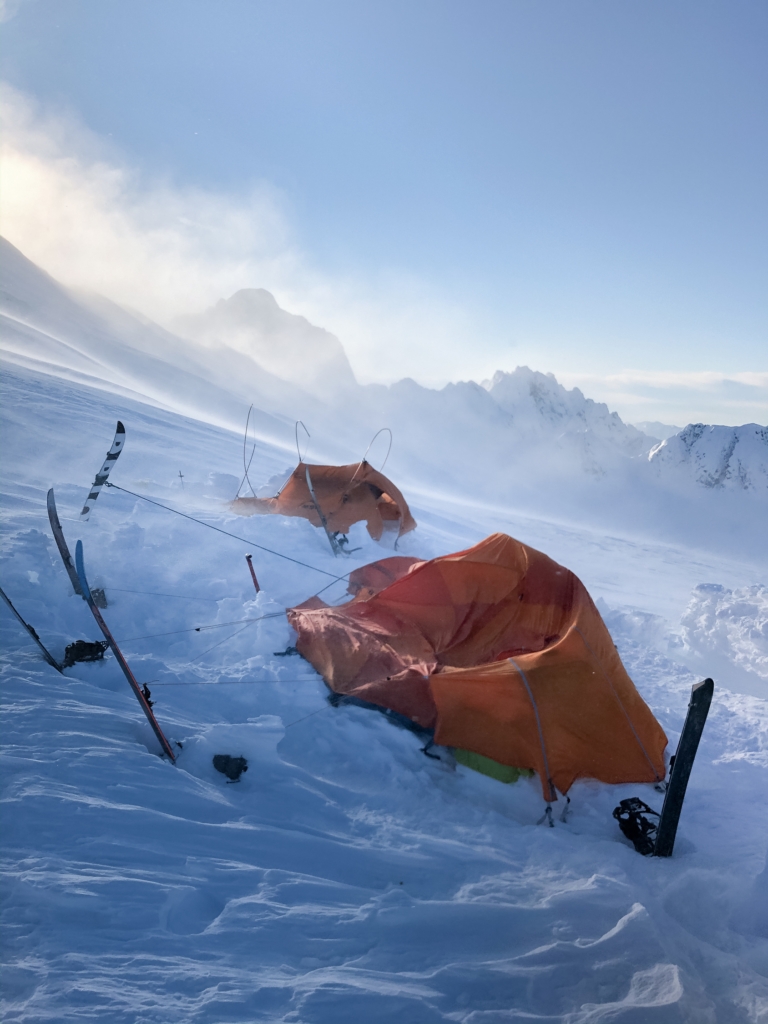
Nick Russell and Rob Massie’s flattened tents. Coast Mountains, British Columbia. Kieran Brownie
I do love the wind. I love the features it creates, the howls of compressed air pushing through rocky spires. I love observing the conversation between mediums and I find a similar beauty between these and the lines humans draw on mountains with their skis—the shapes of interrelation—as in water and stone or wind and snow. But this is not a conversation, this is a lecture. Our camp is in tatters.
Plumes of snow a thousand feet high are streaming off the summits around us the next day; we are witnessing the mountain move. In less than twenty-four hours every surface is scraped clean, the entire range transformed. Throughout the day the sastrugi wiggle along the surface like a mirage, patina spreads on ridges, polished to a shiny glaze before our eyes. Every path we have walked, any snow we have stood on or touched remains somewhat intact, yet delicately excavated as if by an archeologist’s brush, as they study our movements. Individual footprints are preserved, as are small pillars of yellow ice where someone has peed. The wind has found its way through every crack and seam of our snow walls. Those that are still standing have been shaved down to minimalist sculptures, barely there. The camp is sublimating, the ice crystals are returning where they came from, somewhere over the Salish Sea some fifty miles south of here. But the next storm will bring them back, just like we will return to these mountains—both tantalized by a seemingly Sisyphean task.
And in the midst of all of this, in the thick of it, these three days are punctuated every few hours by the ding of someone’s cell phone catching a signal from the towers to the east, near the town of Squamish (hardly ten miles away as the crow flies)—a news update, or a text from a loved one. I imagine them brought to us on the wind. Covid-19 is spreading; the US has declared a state of emergency, airports are shutting down, the Canadian border, and others, are closing; the world is grinding to a halt. It becomes difficult to discern what’s worse—the winds up here or the news down there.
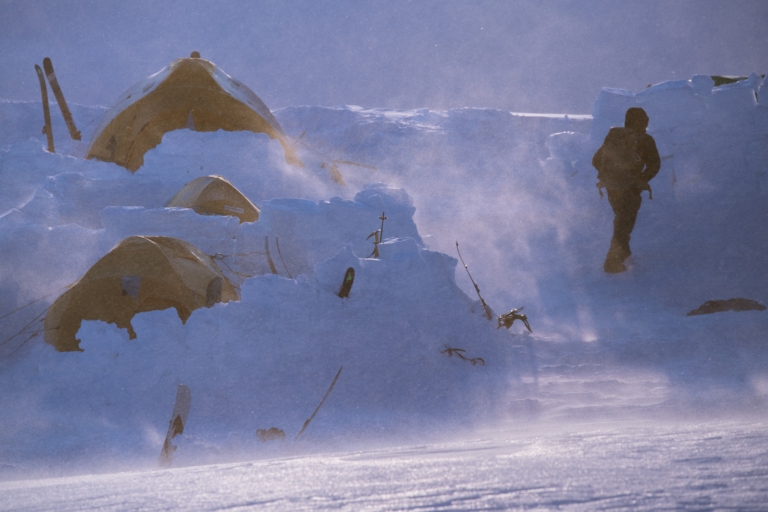
Blake Jorgenson weaves between the walls of camp on the group’s final evening; stuffsacks, tent bags, and every ski, snowboard, ice axe and pole (even a propane tank) ended up being repurposed to keep camp from blowing away. Coast Mountains, British Columbia. Kieran Brownie
In the 72 hours between our drop-off—when we still felt like things were under our control—and when our feet hit the ground back at the Squamish airport, everything has changed. Not just the snowpack in the high peaks, but everything in the valley, too. The grocery store is empty when I arrive—that is, it’s full of people, but there’s no food on the shelves. I watch a young woman scrape the last grains of pesticide-free rice from the bulk bin before I continue to traverse the aisles searching for alternatives. I hear a shelf-stocker talking with a coworker, “Not sure what this is all about, there’s plenty of food in the back.” I pause for a moment, letting the sense of urgency move through me, listening to the soft sound of a generic FM radio station from speakers mounted to the tall ceiling as I stand motionless on linoleum floors between empty shelves. I look at the grocery bags in my hands, filled with unexpected items—each a compromise between what I want and what is available—and then look back to the people as they search for whatever it is they are looking for. I think of the ridge where I watched the wind scribble lessons in snowdrifts, and I wonder what I might have missed.
Outside the grocery store, I drop into the seat of my old minivan and start the engine, easing the old beast out of the parking lot and passing people with arms full of supplies, and then I turn onto the highway heading south, toward home. My face stings from the sandblasting of the last three days and I can feel the warmth of the sun, still perched above the eastern ridge of the valley as it reflects off the water of the Howe Sound. This is the southernmost fjord of the entire Coast Mountains range, and granite peaks and forested valleys stretch from here to Alaska—an almost incomprehensible distance. Over the last few months Covid-19 has crept across the globe, only a distant news story at first, and now all of a sudden it has taken root in reality, in my own town. I feel strange—a familiar strange, that same feeling I had after driving across Canada, averaging 700 miles a day, a pace that would have taken me around the world in 40 days and 40 nights. On the last day, once the rhythm had been found, it felt like I could have kept going on and on until I was right back where I started. The world felt small then, a scale I could grasp. And now it felt even smaller, because if someone else on the other side of the world could affect me and my community, then my actions—in this seemingly endless expanse of loss and unknowing—have the potential to do the same.
